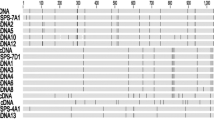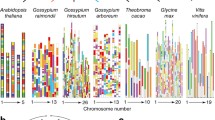Abstract
The acetohydroxyacid synthase (AHAS) gene family of the cotton AD allotetraploid Gossypium hirsutum has been cloned and characterized. We have identified six different AHAS genes from an analysis of genomic clones and Southern blots of genomic DNA. Four of the six genes are organized as tandem pairs, in which the genes are separated by only 2–3 kb. Conservation of restriction fragment length polymorphisms between G. hirsutum and A-genome and D-genome-containing diploid cottons was sufficient to assign the single genes in clones A5 and A19 to the A and D subgenomes, respectively. Each diploid genome has one tandem pair, but in these cases we could not make specific subgenomic assignments. DNA and deduced amino acid sequences were determined for the A5 and A19 genes, and an AHAS cDNA clone isolated from a leaflibrary. The sequence of the A19 gene matches that of the cDNA clone, while the A5 gene is 97.8% similar. The four genes comprising the tandem pairs are much less similar to the cDNA clone. The deduced amino acid sequences of the mature polypeptides encoded by the A5 and A19 genes are collinear with the housekeeping forms of AHAS from Arabidopsis thaliana, Nicotiana tabacum and Brassica napus. The constitutive expression of A5 and A19 was confirmed with RNase protection assays and northern blots. We conclude that these genes encode the main house-keeping froms of AHAS in G. hirsutum. Among the four AHAS genes comprising the two tandem pairs, at least two are functional. These genes exhibit either low-level constitutive expression (one or both of the ‘downstream’ genes of each pair), or highly specific expression in reproductive tissue (one or both of the ‘upstream’ genes of each pair). The AHAS gene family of G. hirsutum is more complex than that of other plants so far examined.
Similar content being viewed by others
References
Anderson DM, Hudspeth RL, Hobbs SL, Grula JW: Chlorophyll a/b-binding protein gene expression in cotton. Plant Physiol 102: 1047–1048 (1993).
Benton WD, Davis RW: Screening λgt recombinant clones by hybridization to single plaques in situ. Science 196: 180–182 (1977).
Chaleff RS, Ray TB: Herbicide-resistant mutants from tobacco cell cultures. Science 223: 1148–1151 (1984).
Dellaporta SL, Wood J, Hicks JB: A plant DNA mini preparation: Version II. Plant Mol Biol Rep 1: 19–21 (1983).
Endrizzi JE, Turcotte EL, Kohel RJ: Genetics, cytology, and evolution of Gossypium. Adv Genet 23: 271–375 (1985).
Frischhauf AM, Lehrach H, Poustka A, Murray N: Lambda replacement vectors carrying polylinker sequences. J Mol Biol 170: 827–842 (1983).
Galau GA, Bass HW, Hughes DW: Restriction fragment length polymorphisms in diploid and allotetraploid Gossypium: assigning the late embryogenesis-abundant (Lea) alloalleles in G. hirsutum. Mol Gen Genet 211: 305–314 (1988).
Galau GA, Hughes DW: Coordinate accumulation of homeologous transcripts of seven cotton Lea gene families during embryogenesis and germination. Devel Biol 123: 213–221 (1987).
Goldberg RB, Hoscheck G, Tam SH, Ditta GS, Breidenbach RW: Abundance, diversity and regulation of mRNA sequence sets in soybean embryogenesis. Devel Biol 83: 201–217 (1981).
Graham MW, Doherty JP, Woodcock DM: Efficient construction of plant genomic libraries requires the use of mcr-host strains and packaging mixes. Plant Mol Biol Rep 8: 18–27 (1990).
Gubler U, Hoffman BJ: A simple and very efficient method for generating cDNA libraries. Gene 25: 263–269 (1983).
Hamilton DA, Roy M, Rueda J, Sindhu RK, Sanford J, Mascarenhas JP: Dissection of a pollen-specific promoter from maize by transient transformation assays. Plant Mol Biol 18: 211–218 (1992).
Haughn GW, Smith J, Mazur B, Somerville C: Transformation with a mutant Arabidopsis acetolactate synthase gene renders tobacco resistant to sulfonylurea herbicides. Mol Gen Genet 211: 266–271 (1988).
Jackson AO, Larkins BA: Influence of ionic strength, pH, and chelation of divalent metals on isolation of polysomes from tobacco leaves. Plant Physiol 57: 5–10 (1976).
Jefferson RA: Assaying chimeric genes in plants: The GUS gene fusion system. Plant Mol Biol Rep 5: 387–405 (1987).
Keeler SJ, Sanders P, Smith JK, Mazur BJ: Regulation of tobacco acetolactate synthase gene expression. Plant Physiol 102: 1009–1018 (1993).
Klessig DF, Berry JO: Improved filter hybridization method for detection of single copy sequences in large eukaryotic genomes. Plant Mol Biol Rep 1: 12–18 (1983).
Lee KY, Townsend J, Tepperman J, Black M, Chui C-F, Mazur B, Dunsmuir P, Bedbrook J: The molecular basis of sulfonylurea herbicide resistance in tobacco. EMBO J 7: 1241–1248 (1988).
Maniatis T, Fritsch EF, Sambrook J: Molecular Cloning: A Laboratory Manual. Cold Spring Harbor Laboratory, Cold Spring Harbor, NY (1982).
Mazur BJ, Chui C-F, Smith JK: Isolation and characterization of plant genes coding for acetolactate synthase, the target enzyme for two classes of herbicides. Plant Physiol 85: 1110–1117 (1987).
Mazur BJ, Falco SC: The development of herbicide resistant crops. Annu Rev Plant Physiol 40: 441–470 (1989).
Meyerowitz EM, Pruitt RE: Arabidopsis thaliana and plant molecular genetics. Science 229: 1214–1218 (1985).
Norrander J, Kempe T, Messing J: Construction of improved M13 vectors using oligodeoxynucleotide-directed mutagenesis. Gene 26: 101–106 (1983).
Odell JT, Caimi PG, Yadav NS, Mauvais CJ: Comparison of increased expression of wild-type and herbicide-resistant acetolactate synthase genes in transgenic plants, and indication of posttranscriptional limitation on enzyme activity. Plant Physiol 94: 1647–1654 (1990).
Ouellet T, Rutledge RG, Miki BL: Members of the acetohydroxyacid synthase multigene family of Brassica napus have divergent patterns of expression. Plant J 2: 321–330 (1992).
Poehlman JM: Breeding Field Crops, 2nd ed., pp. 355–357. Avi Publishing, Westport, CT (1979).
Rutledge RG, Ouellet T, Hattori J, Miki BL: Molecular characterization and genetic origin of the Brassica napus acetohydroxyacid synthase multigene family. Mol Gen Genet 229: 31040 (1991).
Sanger F, Micklen S, Coulson AR: DNA sequencing with chain terminating inhibitors. Proc Natl Acad Sci USA 74: 5463–5467 (1977).
Sathasivan K, Haughn GW, Murai N: Molecular basis of imidazolinone herbicide resistance in Arabidopsis thaliana var. Columbia. Plant Physiol 97: 1044–1050 (1991).
Singh B, Schmitt G, Lillis M, Hand JM, Misra R: Overexpression of acetohydroxyacid synthase from Arabidopsis as an inducible fusion protein in Escherichia coli. Plant Physiol 97: 657–662 (1991).
Skuzeski JM, Nichols LM, Gesteland RF: Analysis of leaky viral translation termination codons in vivo by transient expression of improved β-glucuronidase vectors. Plant Mol Biol 15: 65–79 (1990).
Wiersma PA, Schmiemann MG, Condie JA, Crosby WL, Moloney MM: Isolation, expression and phylogenetic inheritance of an actolactate synthase gene from Brassica napus. Mol Gen Genet 219: 413–420 (1989).
Umbarger HE: Amino acid biosynthesis and its regulation. Annu Rev Biochem 47: 533–606 (1978).
Ye G-N, Daniell H, Sanford JC: Optimization of delivery or foreign DNA into higher-plant chloroplasts. Plant Mol Biol 15: 809–819 (1990).
Author information
Authors and Affiliations
Rights and permissions
About this article
Cite this article
Grula, J.W., Hudspeth, R.L., Hobbs, S.L. et al. Organization, inheritance and expression of acetohydroxyacid synthase genes in the cotton allotetraploid Gossypium hirsutum . Plant Mol Biol 28, 837–846 (1995). https://doi.org/10.1007/BF00042069
Received:
Accepted:
Issue Date:
DOI: https://doi.org/10.1007/BF00042069




